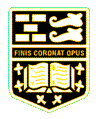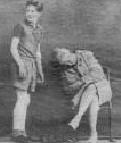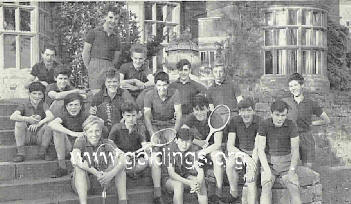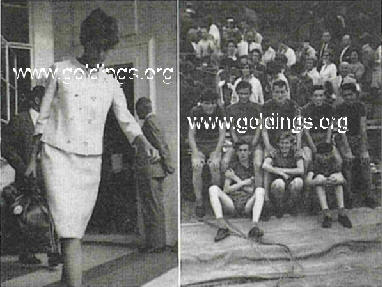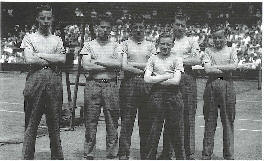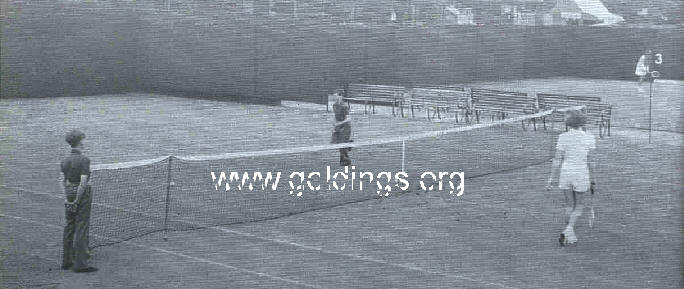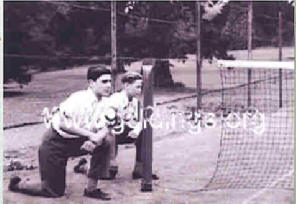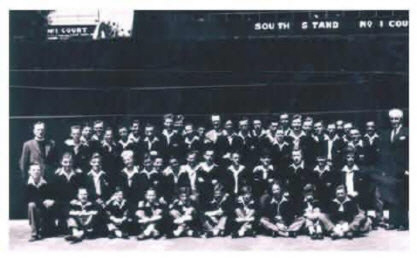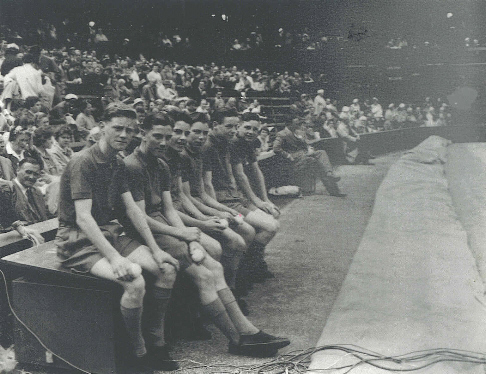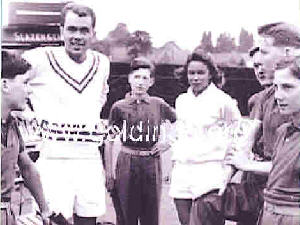|
Wimbledon, 1960
THIS YEAR'S Wimbledon once again provided all the splendour and glamour of past years. Whilst walking round, judging from the
clothes and hats some of the ladies wear, you would think that you were at a fashion show. Men also put on their best suits for this,
one of the world's major sporting events.
The tennis produced some very exciting and unexpected results, the one that springs to mind being the Men's Doubles final in which
the twenty-one year-old Mexican, Rafael Osuna, and the seventeen-year-old American Junior Champion, Dennis Ralston, defeated
the British pair, Mike Davies and Bobby Wilson in three straight sets. Both pairs were unseeded.
After the British girls' victory in the Wightman Cup, most people expected them to do well here. Two of them, Christine Truman and
Ann Haydon played very well and reached the semi-finals, Christine Truman going down to the eventual winner, Maria Bueno, in
three sets. If she had kept up the form she showed in the second set which she won 7-5, she could quite easily have been in the final.
Ann Haydon also went down over three sets against Sandra Reynolds of South Africa. Christine Truman gave everyone a shock
when in the third round she came up against Dorothy Knode of America, and lost the first set 1-6. She soon recovered though and
easily won the last two, 6-0, 6-3. Also in the fifth round she had a tough time against Karen Hantze, whom she had previously beaten
in the Wightman Cup. Once again she lost the first set; this time 4-6, but pulled back to win the last two, 6-4, 6-4. Ann Haydon also
had a tough task of disposing of Miss R. Schuurman in the fifth round. Ann won the first set 7-5, lost the second 1-6, and won the
third 6-2, gaining herself a place in the semi-final. Another British girl, Miss Angela Mortimer who was seeded No. 5, reached the
quarterfinals and then lost to Maria Bueno 1-6, 1-6. One of the most exciting of the ladies' matches was the Centre Court match
between No. 8 seed Sandra Reynolds and No. 2 seed Darlene Hard. Sandra Reynolds won the first set 6-1, lost the second 2-6, and
won the final set 6-1.
The first seeded lady to be knocked out was Mrs. Z. Kormoczy, of Hungary, who lost in the second round to Miss J. S. Hopps of
America. Mrs. Kormoczy is rated as the finest hard-court player in the world. Miss Anna Dmitrieva surprised everyone by beating
Darlene Hard in the first set of their fourth round match, 7-5. But as often happens, Miss Hard went on to win the last two sets 6-2,
6-1. Miss Dmitrieva was one of the two Russian girls in the tournament. The other, Miss Rjazanova, lost in the first round to Britain's
Miss R. Hales. In the final of the Ladies' Singles, Maria Bueno proved that she is undoubtedly the best woman player in the world
today. Miss Bueno, the twenty-year-old Brazilian schoolteacher, defeated South Africa's Sandra Reynolds 7-5, 6-0. In the third game
of the second set there were nine dueces, proving that the game was closer than the score suggests.
In the Men's Singles, the competition was just as keen, the final being between Neil Fraser and his fellow Australian Rod Laver
whom he beat in three sets. Incidentally, both these two are lefthanders. Neil Fraser was very lucky in the fifth round when he met
Earl Bucholz of America, the No. 8 seed. The score was two sets to one to Bucholtz and fifteen games all in the fourth set. Bucholz
went for a ball and then doubled up with pain, he had cramp in his leg. A doctor came on and soon cured him of this, and play was
resumed. After playing for a short while he once again collapsed, this time with an ankle injury. Play was called off, and Bucholz
was carried off on a stretcher. This was the worst thing that could have happened to him as he was in an advantageous position and
could very well have won the match. One of the best matches of the tournament was the one between R. Krishnan, the No. 7 seed
from India, and L. Ayala the No. 4 seed from Chile. Krishnan won the match mainly due to the perfect placing of his shots. The final
score was 7-5, 10-8, 6-2, which earned Krishnan a place in the semi-final. Another exciting match was the one between Pietrangeli,
the No. 5 seed from Italy, and Mackay, the No. 2 seed from America. Pietrangeli, who has since been offered professional terms by
Jack Kramer, won the match 16-14, 6-2, 3-6, 6-4. At the end of this match, Pietrangeli ran up to shake hands with Mackay, whilst
doing so, he threw his racket in the air. It came down and hit him on the top of his head, much to the amusement of the crowd. In this
event all eight seeds reached the last eight in the fifth round. The semi-finalists were Pietrangeli v. Laver and Krishnan v. Fraser.
In the Men's Doubles event, Osuna and Ralston reached the final by beating the No. 4 seeds Sirola and Pietrangeli in five sets, then
they beat Lundquist and Schmidt, Gaertner and Veermark, Laver and Mark, the No. 2 seeds, and in the final beat Da vies and Wilson.
Davies and Wilson surprised everyone by beating the No. i seeds, Emerson and Fraser of Australia, in the quarter-finals. Only one
seeded pair in this event reached the semi-finals, they being Laver and Mark, the Australian pair.
The Ladies' Doubles was won by No. i seeds Maria Bueno and Darlene Hard, who beat South Africans and No. 4 seeds, Sandra
Reynolds and Renee Schuurman in the final in two straight sets, after narrowly beating No. 3 seeds Karen Hantze and Janet Hopps of
America in the semi-final, Miss Reynolds and Miss Schuurman having beaten Jan Lehane and Mrs. K. Hawton. The most successful
of the British pairs in the doubles were Miss S. Armstrong and Miss D. Catt, who reached the quarter-finals and then lost to Miss
Hantze and Miss Hopps. Ann Haydon and Angela Mortimer, another British couple, reached the third round and then lost to Sandra
Reynolds and Renee Schuurman. The Ladies' Doubles event had the least entries, forty-eight pairs in all.
The Mixed Doubles Tournament also produced some very interesting tennis. In the final the No. i seeds Rod Laver and Darlene Hard
beat the No. 2 seeds Bob Howe and Maria Bueno in three sets. A lot of controversy was caused in the final set of this match with the
score 5-2 to Howe and Miss Bueno, for as they were changing ends, Darlene Hard rushed off the court without permission from the
umpire. She was off for six minutes during which time Miss Bueno went to see what was happening whilst the two men sat on the
ice-box and had a drink. When Miss Hard returned, play was resumed, and from trailing 2-5, Laver and Miss Hard went on to win the
final set 7-5. Javorsky and Miss V. Puzeyova, the top two Czechoslovakian players, played very well and reached the semifinal before
losing to Howe and Miss Bueno in three sets. Another unseeded pair, Mark and Miss Hopps, also reached the semi-final and then lost
to Laver and Miss Hard.
In the All-England Plate Men's Final, T. Ulrich of Denmark beat 0. Sirola of Italy. In the Ladies' final Miss D. Catt of England beat
Miss J. W. Cawthorn, also of England.
In the Junior Finals, the Boys' event was won by A. R. Mandel-ston of South Africa who beat J. Mukerjea of India in the final. The
Girl's event was won by Miss Karen Hantze of America, who beat Miss L. Hutchings of South Africa.
Althea Gibson, in a report in one of the evening papers, gave the ball-boys a very creditable report, which coming from her is proof
that once again the ball-boys did their very best. Also this year twelve boys from the School acted as ball-boys in the Davis Cup-tie
between Great Britain and Italy. This is the first time the School has provided boys for this tournament.
W. CHARLTON AND D. CHARLTON Goldonian Summer 1960
|
